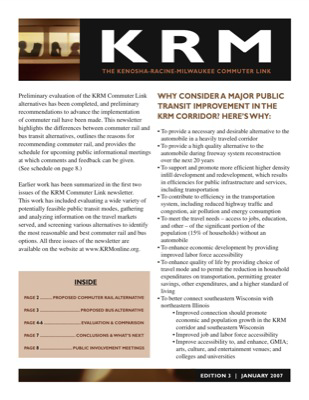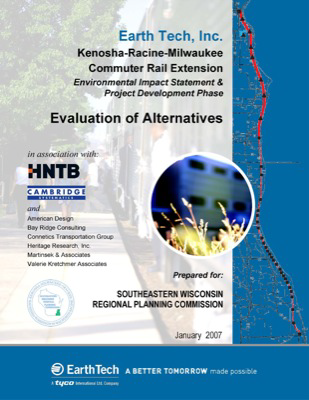No Light Rail in Vancouver!
A Commuter Train for Milwaukee?

Normally, the Antiplanner does not like to use names like “liars” and “cheaters,” preferring to let the facts speak for themselves. But, time and again, these words turn out to perfectly apply to the people who put together rail transit projects.
Take, for example, the Southeastern Wisconsin Regional Transit Authority, or RTA
for short, which covers Kenosha, Racine, and Milwaukee counties. Created in 2005,
RTA wants to run a commuter-
According to RTA’s latest newsletter, the KRM would cost about $200 million to start up and would require a $6.3 million annual operating subsidy. For that it would carry about 1.7 million trips per year, which translates to 6,700 per weekday.
In other words, RTA wants to spend $200 million to take 3,350 people to and from
work each day. The Milwaukee-
The planned commuter line would run 14 round trips per day, which means each train would have about 240 people on board. That’s about five bus loads. So why not just buy five buses for each planned trainset and move people by bus instead?
The newsletter explains that RTA considered a bus alternative, but it would attract
only a third as many people as the rail line. It would also cost only an eighth as
much to start up, so I always wonder why don’t they just invest three-
But then I noticed that the rail line was projected to have seven stops between Milwaukee and Kenosha, while the bus line would stop 27 times. As a result, the bus would take almost twice as long as the train. No wonder it attracted so few people!
The train would average just 38 miles per hour and RTA admits that it would not go significantly faster than motor vehicles, so there is no reason why buses could not be run on schedules similar to the train. So why didn’t they consider an alternative in which buses stopped only seven times?
It turns out they did. The report from the consultant hired by RTA included a bus-
Naturally, RTA told the consultant to drop this alternative from further consideration. It seems they did a focus group and people liked trains better than buses (as long as someone else paid for them, of course). But RTA continued to “consider” the other bus alternative (called “TSM” for transportation system management), no doubt because the FTA requires them to have such an alternative to be considered for federal funding.
The consultant had also estimated that the bus-
Instead, RTA is foisting the rail alternative on an unsuspecting public. Who would ever think that loyal public servants from a public agency would cover up the fact that buses can do as good a job as trains for a lot less money? Only those who know that most rail boosters are liars and cheaters.
9
Trackback • Posted in Transportation
Reprinted from The Antiplanner

